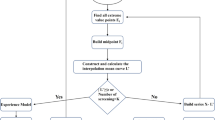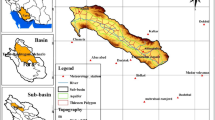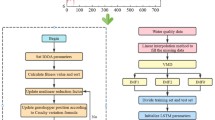Abstract
The improvement of groundwater burial depth prediction accuracy is an important guiding significance for the development and management of groundwater resources. Groundwater burial depth sequence has the characteristics of uncertainty and nonlinearity. Variational mode decomposition (VMD) has a powerful advantage in dealing with nonlinearity. Wavelet signal denoising (WSD) can reduce the high-frequency component noise so that its abrupt change point is reduced. Meanwhile, ELMAN neural network has the advantages of stability, adaptability to time-lapse, and dynamic memory. Based on their advantages, the combined VMD-WSD-ELMAN model is developed and applied to groundwater prediction in the People’s Victory Canal Irrigation Area. To verify the reliability of the model, the prediction results were compared with the single ELMAN network and EMD-ELMAN model, and the results showed that the combined VMD-WSD-ELMAN model has higher accuracy and 100% qualification rate, and the prediction results are better than the single ELMAN model and EMD-ELMAN model. The model reveals the future spatial distribution of groundwater and its dynamic changes with time and provides a basis for future dynamic artificial numerical simulation.









Similar content being viewed by others
Availability of data and materials
Data and materials are available from the corresponding author upon request.
References
Chen X, Wang FX, Qi WY, Zhou T (2018) Application of BP neural network model based on genetic algorithm in groundwater burial depth prediction–Mengcheng County as an example. Water Resour Hydropower Technol 49(04):1–7
Das AB, Bhuiyan M (2016) Discrimination of focal and non-focal EEG signals using entropy-based features in EEMD and CEEMDAN domains[C]// International Conference on Electrical & Computer Engineering. IEEE
Devi MS, Rahamathulla V (2020) Prediction of groundwater level in district level by implementing machine learning and advanced softcomputing techniques. 12(1):6-7
Huang RQ, Tian J (2021) Wavelet-based Elman neural network with the modified differential evolution algorithm for forecasting foreign exchange rates. J Syst Sci Inf 9(04):421–439
Jaafarzadeh MS, Tahmasebipour N, Haghizadeh A, Pourghasemi HR, Rouhani H (2021) Groundwater recharge potential zonation using an ensemble of machine learning and bivariate statistical models. Sci Rep 11(1):5587
Jami AA, Himel MU, Hasan K, Basak SR, Mita AF (2020) NARX neural network approach for the monthly prediction of groundwater levels in Sylhet Sadar, Bangladesh. J Groundw Sci Eng 8(2):9
Kai SA, Tz A, Zl B, Lu WB, Rw A, Xc A (2021) Methodology for optimal parametrization of the polymer membrane fuel cell based on Elman neural network method and Quantum Water Strider Algorithm. Energy Rep 7:2625–2634
Li X, Tsai TC (2009) Bayesian model averaging for groundwater head prediction and uncertainty analysis using multimodel and multimethod. Water Resour Res 45(9):627–643
Lv HF, Zhao XH, Sang YT, Zhu XP, Zhang LJ (2020) Research on monthly runoff prediction method based on VMD-LSSVM. China Rural Water Conserv Hydropower (08):166–170+176
Mallikarjuna B, Sathish K, Krishna PV, Viswanathan R (2020) The effective SVM-based binary prediction of ground water table. Evol Intel 14(1):779–787
Min G, Hpdef G, Yca B, Sp C (2021) Application of the variational mode decomposition (VMD) method to river tides. Estuar Coast Shelf Sci 261(31):107570
Singh VK, Govindarasu M (2021) A cyber-physical anomaly detection for wide-area protection using machine learning. IEEE Trans Smart Grid PP (99):1–1
Song WZ, Xiao C (2011) A novel second generation wavelet transform algorithm applied in laser radar echo signal denoising. IEEE: 123–126
Vahid M, Mehdi V, Bagher S, Negin B (2013) A wavelet-ANFIS hybrid model for groundwater level forecasting for different prediction periods. Water Resour Manage 27:1301–1321
Veza I, Said M, Latiff ZA, Abas MA (2021) Application of Elman and Cascade neural network (ENN and CNN) in comparison with adaptive neuro fuzzy inference system (ANFIS) to predict key fuel properties of ABE-diesel blends. Int J Green Energy 18(14):1510–1522
Wang Y, Lu WX, Bian JM, Hou ZY (2014) Research on wavelet neural network in the prediction of shallow groundwater burial depth in Baicheng area. Water Conserv Irrig 12:64–67
Wang Y, Wang L, Yang F, Di W, Chang Q (2021) Advantages of direct input-to-output connections in neural networks: the Elman network for stock index forecasting. Inf Sci 547:1066–1079
Yang QX, Zhang QN. (2020) Improved nonparametric time series model in groundwater level dynamic forecasting. China Rural Water Conserv Hydropower (03):62–65+73.
Youngmin S, Sungwon K, Vijay S (2018) Machine learning models coupled with variational mode decomposition: a new approach for modeling daily rainfall-runoff. Atmosphere 9(7):251
Zhang W, Qu Z, Zhang K, Mao W, Ma Y, Fan X (2017) A combined model based on CEEMDAN and modified flower pollination algorithm for wind speed forecasting. Energy Convers Manag 136(MAR.):439–451
Zhang CF Chen HR, Yue ZQ (2020) Groundwater burial depth simulation prediction based on long and short term memory network (LSTM)-an example analysis of Guanzhong Plain. China Rural Water Conserv Hydropower (09):127–131+137
Zhao WJ, Ma XY, Li JL, Zhang JX (2008) Grey time series combination model and its application in groundwater depth prediction. Math Pract Underst 18:70–76
Zhu H, Wang J, Chen X (2020) Application of RBF neural network model in groundwater depth prediction. Yellow River
Funding
This work was supported by the Key Scientific Research Project of Colleges and Universities in Henan Province (CN) (grant numbers 17A570004).
Author information
Authors and Affiliations
Contributions
All authors contributed to the study conception and design. Writing and editing: Xianqi Zhang and Dong Zhao; chart editing: Bingsen Duan; preliminary data collection: Wenbao Qiao. All authors read and approved the final manuscript.
Corresponding author
Ethics declarations
Ethics approval
Not applicable.
Consent to participate
Not applicable.
Consent to publish
Not applicable.
Competing interests
The authors declare no competing interests.
Additional information
Communicated by Marcus Schulz
Publisher's note
Springer Nature remains neutral with regard to jurisdictional claims in published maps and institutional affiliations.
Rights and permissions
About this article
Cite this article
Zhang, X., Zhao, D., Duan, B. et al. A novel groundwater burial depth prediction model—based on the combined VMD-WSD-ELMAN model. Environ Sci Pollut Res 29, 76310–76320 (2022). https://doi.org/10.1007/s11356-022-21209-7
Received:
Accepted:
Published:
Issue Date:
DOI: https://doi.org/10.1007/s11356-022-21209-7




